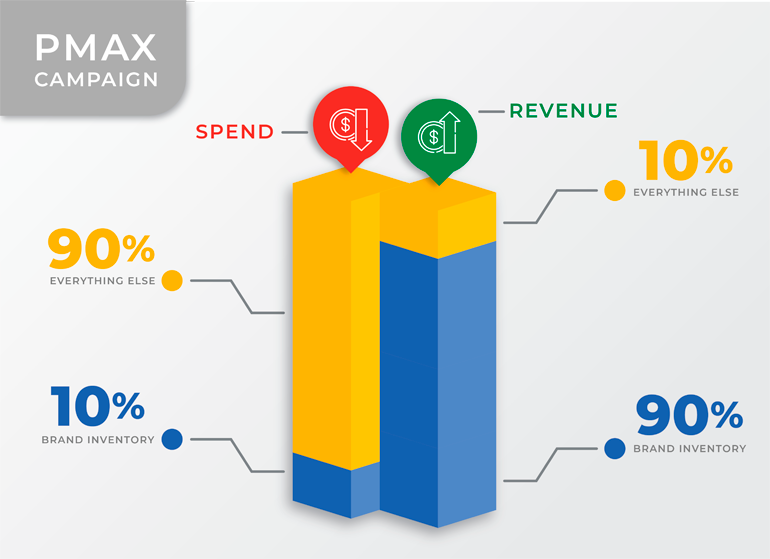PPC
Running Performance Max Against Brand is a Waste

If you’re like the majority of Google Ads advertisers, you’re running Performance Max campaigns. You’re also likely wasting a ton of money on it. Google makes it challenging to exclude branded keywords from Performance Max, while claiming the brand terms that do show up in these campaigns are incremental.
At our PPC agency, Taikun, where we manage tens of millions in Google ad spend per year, we have not seen this proposition supported by evidence. In fact we have found time and again that keeping branded terms live in PMax gives Google a license to waste your money.
Is Brand Search Incremental?
Before diving into the specifics of how including brand in PMax wastes money, it is important to discuss whether brand spend ever drives incremental revenue
Geo lift tests we have conducted on brand spend, within both shopping and search, with a number of brands, have found in each case that ad spend was found to be completely non incremental. That is, it generated no additional (net) revenue. This is supported by other companies which have seen similar results.
Despite the lack of incrementality, there are situations where spending on brand makes sense. For example: To deter competitors or retail partners from bidding on your terms; product or service segmentation that meaningfully benefits from better control of landing pages; and when brand terms overlap with nonbrand searches.
Whether any of the above apply or not, it’s important to remember that when running brand there’s no guarantee it will drive incremental sales. If you have the volume to run a geo lift test, it’s recommended.
Understanding how the sausage is made
Regardless of whether running brand on search or shopping is incremental for your business, there’s one way to ensure it will negatively impact your incremental volume: running it in PMax.
PMax gives you access to Google’s entire ad inventory. It promises to use machine learning to maximize your overall performance across Google’s entire ecosystem. This sounds great in theory. In reality, PMax is a way for Google to sell remnant inventory that you would not intentionally target because of its low quality. That poor performance can be hidden with spend against extremely high intent and high performing brand volume.
For example, if 10% of your spend goes to brand at a 20x ROAS and the other 90% goes to everything else at a 0.5x ROAS, your blend is a 2.45x. Performance looks good on the blend, but in reality you’re incinerating 90% of your ad budget.
This is not a theoretical example. We have seen this play out with varying degrees of severity in every PMax campaign we’ve looked at where brand was combined with nonbrand:

You need to force PMax to work for its conversions. To do that you need to strip brand out completely.
How to Tell if Brand PMax is Wasting Your Budget
You can take a look at your own PMax campaigns and quickly determine if you’re wasting money on brand. If your PMax is performing at a better rate than other nonbrand volume in your account or your meta prospecting, you’re probably running a lot of brand. Likewise, if your campaign is consistently performing above the target, it is a dead giveaway there’s brand in there. Finally, if CPCs are lower than the rest of the account, brand is a likely culprit.
You can also do a rough calculation of how much brand is generating witin the campaign. The insights report of PMax provides data on the search categories that are driving conversions. Add up all the conversions that are credited to search categories with brand terms and compare that to the overall campaign conversion volume. This will give you a rough idea of the percentage of conversions in the campaign being driven by brand.
If it’s more than 30% of the overall conversions, you’re absolutely burning money and you should pull it out of PMax.
Structuring Brand Outside PMax
Removing brand from PMax is annoying but not overly onerous. The first step is requesting Google adds a negative keyword list to your PMax campaign. Here is the form that includes a template to send in the name of your brand terms or dedicated PMax negative keyword list. This allows you to add negative keywords to your PMax campaign.
Note: The brand exclusions structure doesn’t do as good a job of excluding brand terms as a negative keyword list.
Next, you need to set up a brand search campaign on either target impression share, or a manual bidding strategy. Smart bidding is a bad fit for brand search for the same reason we exclude it from PMax: it allows Google to waste money.
The goal with your brand search campaign should be to maximize the delta in real dollars between your spend and revenue generated.
If you’re managing an ecommerce brand, there’s one more campaign that needs to be set up (if you don’t already have one): A branded shopping campaign. A standard shopping campaign with a ROAS target that’s double your nonbrand target will ensure you’re capturing branded shopping inventory as well.
Adjust this target as necessary. Almost no nonbrand will make it into this campaign because PMax takes precedence over standard shopping.
With brand out of PMax, you’ll see volume on that campaign decline substantially as well as performance. Your overall account performance should increase substantially as well.
A Final Note on Google
The advertiser relationship with Google is currently broken. The Google antitrust trial has exposed what many of us in the PPC community have known for years: Google is squeezing advertisers to juice their own profits.
Whenever Google makes changes or encourages advertisers to do things, remember the relationship and ask yourself: “How would this benefit Google?”


















